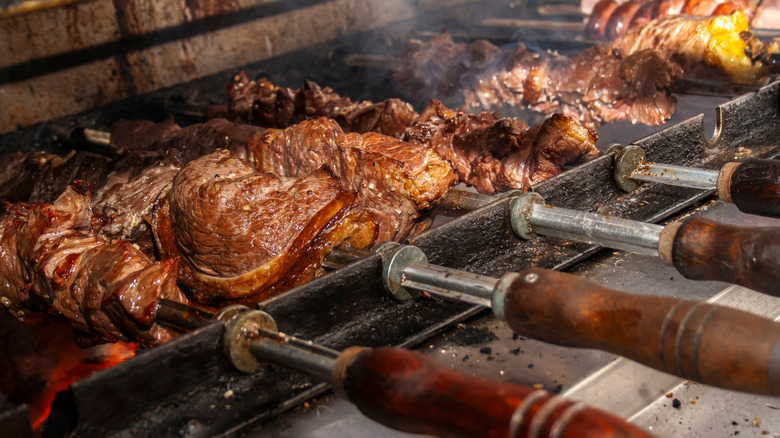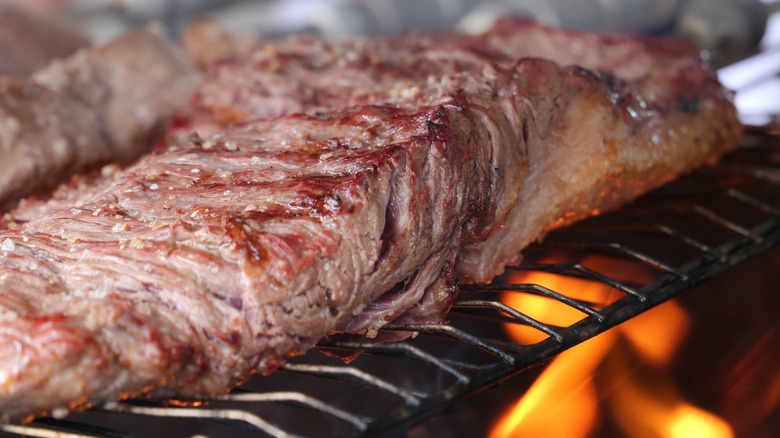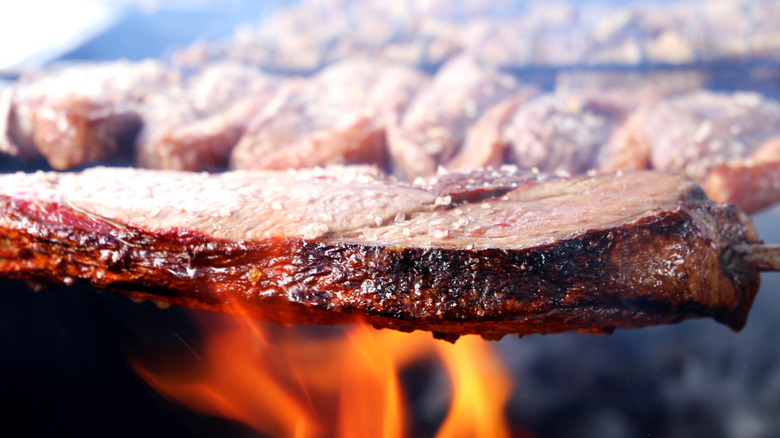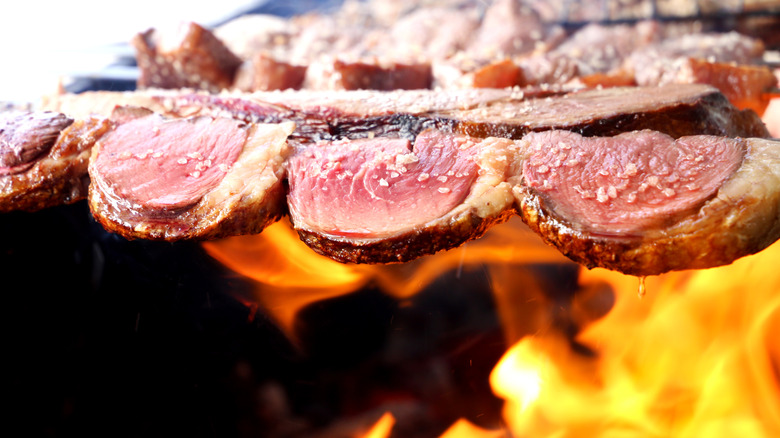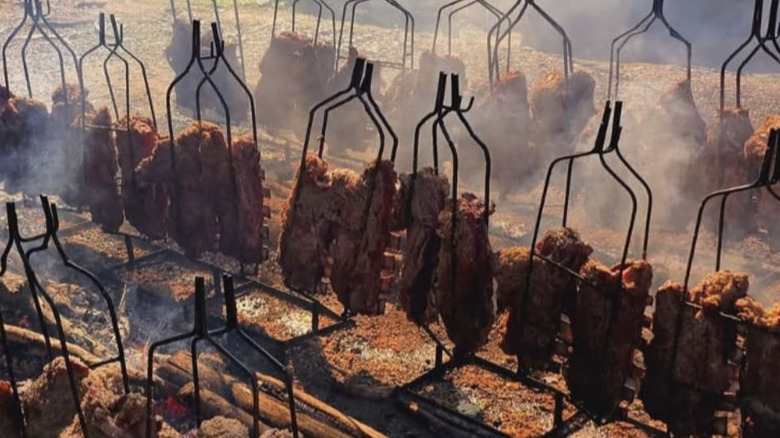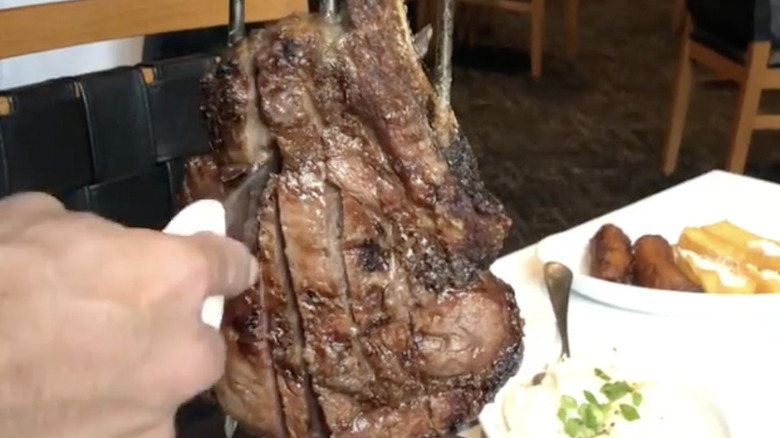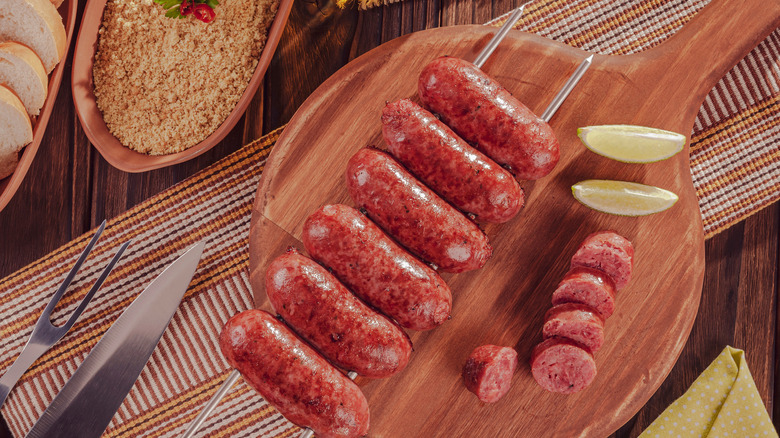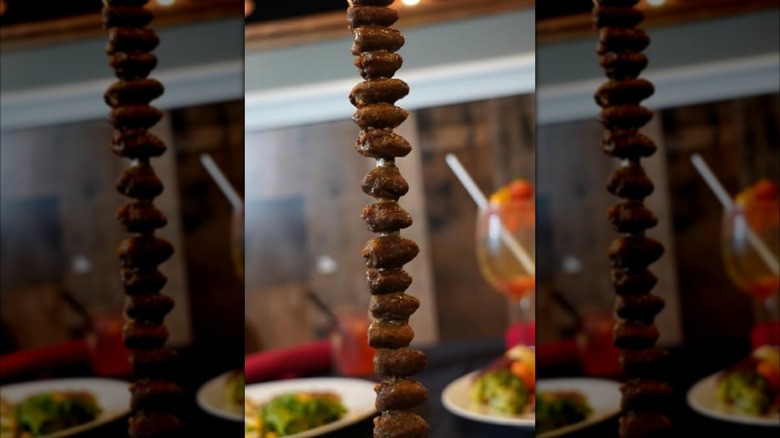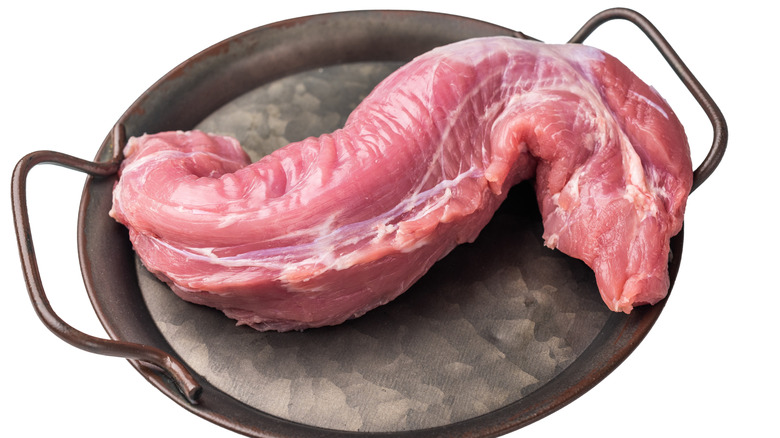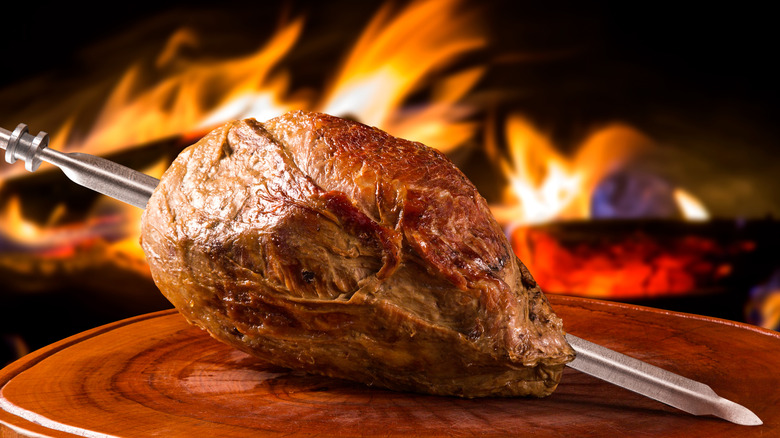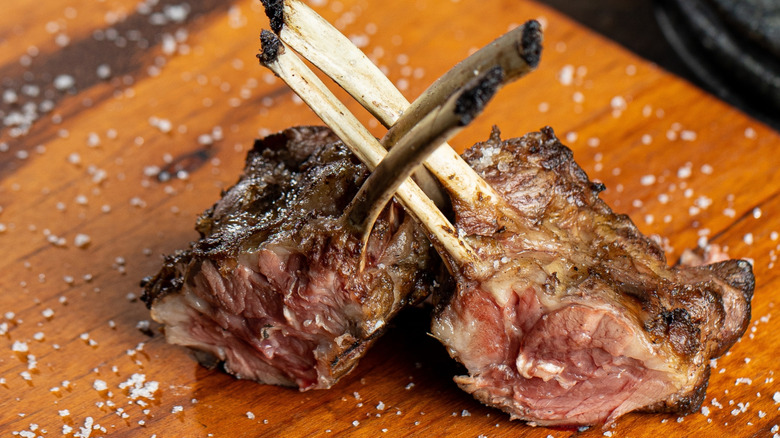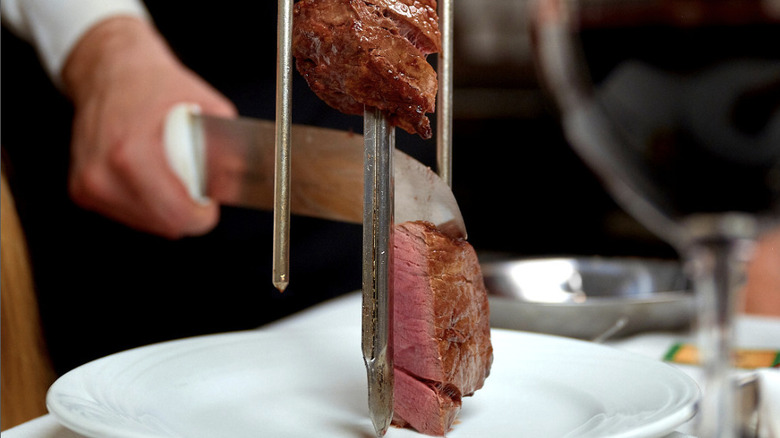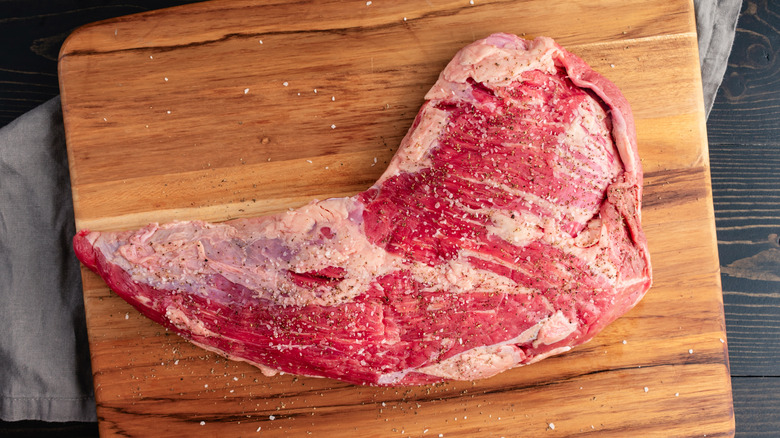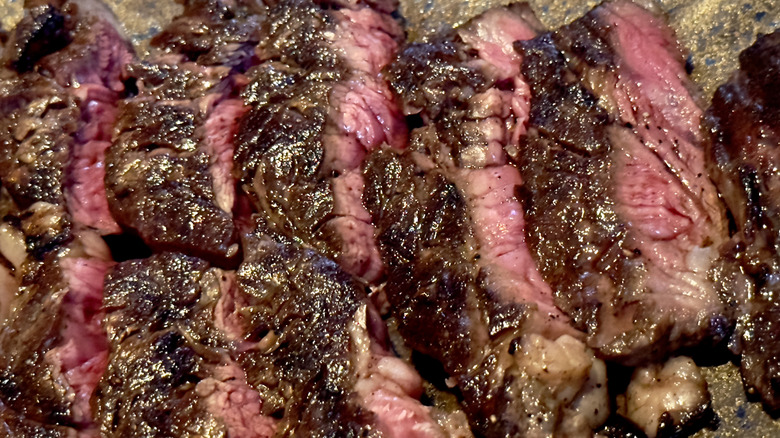A Guide To All Of The Meats At A Brazilian Steakhouse
A night at a Brazilian steakhouse is more a sensory experience than just a nice dinner out, and diners will enjoy two culinary traditions from that South American nation. These houses of meat worship utilize the churrasco method, in which huge portions of protein are grilled over open-flame cooking pits on sword-like metal skewers. Then, servers called gauchos wander around the steakhouse's vast dining rooms bearing those very swords of meat, going from table to table and slicing off as much as diners would like of each meat. This style is called rodizio, which translates to "rotation" in Portuguese.
As gauchos keep coming up to the table with their swords of meat, it can be a dazzling, daunting, delightful, and chaotic experience. A Brazilian steakhouse dinner is a mix of the familiar and the unfamiliar, such as the names of all those meats held aloft in one's presence. Any beginner's guide to Brazilian barbecue needs to come with an explanation into what all those different meats can be. For the most part, they're all commonly consumed cuts of beef (as well as chicken, pork, and lamb selections) that just have different names in Portuguese, and prepared in ways native to the Brazilian culinary tradition. Here then is a primer on the meats you're most likely to find and enjoy at a Brazilian steakhouse.
Fraldinha
The sirloin primal cut, found near the rear of a cow, behind the loin and above the flank, is processed into top sirloin and bottom sirloin. The latter is then divided into large, slightly tougher, lower-fat cuts that are better as roasts and take a while to grill or fire-cook. The bottom sirloin cut holds up especially well in the Brazilian steakhouse cooking method of churrasco, where the slow-roasting over fire, and time, makes it just as flavorful as a top sirloin steak.
In Brazilian cuisine, and at steakhouses in particular, this piece of beef is known as fraldinha, Portuguese for "little flap." It was virtually unheard of in Brazil until the late 1960s when influential restaurateur and butcher Marcos Bassi began stocking it at the behest of a French customer who enjoyed the cut. He served it grilled and sliced on sandwiches.
Served in pieces that are long, flat, and thin, the closest corollary to fraldinha for Americans unfamiliar with Brazilian steakhouses would be flank steak, used in dishes like fajitas. In churrasco establishments, it may arrive straight off the skewer or sword with a pink inside and a crusty, slightly charred exterior.
Alcatra
As the sirloin yields two popular beef cuts important to the makeup of Brazilian steakhouse fare, the bottom sirloin of the fraldinha has its top sirloin counterpart in a piece called alcatra. One of the most calorically light beef options found in steakhouses of any kind, alcatra contains only about 165 calories in a 3 ½ ounce portion, or about 35 less than a similarly sized chunk of the picanha or bottom sirloin. The difference comes from fat. Alcatra is exceptionally lean, and so there isn't a lot of marbling or fat to permeate the muscle, resulting in a slight and shallower beef flavor.
Alcatra isn't interchangeable with top sirloin. It's cut slightly differently, with an eye toward how it will be served in a Brazilian steakhouse. Taken from the top of the top sirloin, it's naturally elongated and hearty, stretching out as long as two or three feet as it's a cow's back muscle. Interpreted as the second-most important and popular cut in churrasco-style eating, it's fired in a larger state before being grandly presented on skewers, from which gauchos carve off more manageable portions.
Picanha
Touted as the most famous or quintessential of any meat, beef or otherwise, served at a Brazilian steakhouse, is the highly sought after picanha. Hailed as the tastiest part of the top sirloin and considered the signature item at multiple Brazilian steakhouse chains and independently operated businesses, it's also known as a beef top sirloin cap, or sirloin culotte. When placed on a meat skewer for roasting over fire in the currasco style, it naturally curls around into a C-shaped crescent that makes it look like half of a medallion, as it's a generous chunk of flavorful beef with the fat cap remaining attached throughout the cooking and presentation. It ranks with the absolute best cuts of steak for juicy grilling, and is also one of the most budget-friendly steak cuts.
The meat portion of the picanha is very lean, but as it heats over a fire, that adjacent strip of fat that wraps around the whole cut mixes and melds into the muscle. That results in a tender, heavily beef-flavored cut that's seasoned usually with only salt. Servers at Brazilian steakhouses cut it very thin for customers, and historically, it's the original churrasco meat in its beef form, although lamb and pork versions do show up at churrasco establishments.
Costela
One of the most eye-catching, show-stopping, tantalizing meats on near constant parade in any of the finer Brazilian steakhouses are the ribs. Grilled over hot flames in the churrasco method, ribs are a standard on the menu at such restaurants that specialize in the rodizio method, be they the smaller variety that comes from pork or the extra-large, extremely meaty and substantially fatty beef ones that really strike an image when hanging off of a skewer. To get the ribs-bearing gaucho at the Brazilian steakhouses to carve you off a bone's worth or two, simply look or listen for costela – that's Portuguese for "rib," and it's used to identify that meat regardless of its origin.
If the costela being cooked and served are beef ribs, Brazilian steakhouses customers are likely to get parts of both kinds, with the plate rib included in the roasting process. Unlike the ribs found in American restaurants and steakhouses, the Brazilian style doesn't involve a whole lot of rubs or sauces, but rather some conservative spicing and plenty of salt. The taste is what one would expect from ribs: savory, rich in protein and fat flavors, and so tender that the gaucho doesn't have to work too hard to remove that meat from the bone.
Chuleta
One of the most majestic and flavorful steaks, a ribeye comes from the beef rib, one of the main primal areas of a cow. Found specifically between the loin and the shoulder, it's served either with the bone still on or removed. The ribeye is highly recognizable and prized for its remarkable marbling, with stripes of white fat moving all throughout the red meat. Any decent steakhouse is going to have a ribeye on its menu, and a Brazilian steakhouse is no exception.
While there are more wallet-friendly steaks to order instead of a ribeye, one might as well indulge in the high-priced steak at an all-you-can-eat Brazilian steakhouse. A gaucho server may circulate the dining room with a sword heavy with thick, whole ribeye steaks with the bone left on if only for show. They've been grilled over an open fire on that very apparatus, although in this restaurant, it's called chuleta, which modestly translates from Portuguese to English as "cutlet" or "chop".
Linguica
Sometimes known as Brazilian sausage, linguica is an international sausage to try at least once, and one of the most important and foundational foods in Portuguese cuisine. When Portugal colonized Brazil, it brought with them its recipes and techniques for preparing smoked sausage, made from minced pork and a host of spices dominated by paprika and garlic. It's a spicy, savory, tangy, and generally powerfully flavored sausage commonly found for sale or served as a series of bent links colored a vibrant red-orange, thanks to the paprika. Linguica means "tongue," but there isn't any beef or pork tongue used in the creation of the smoked and vinegar-brined sausage — it just looks like an extended tongue when completed and heated, according to food lore.
Sometimes billed as Portuguese sausage, linguica strikes an impressive image at Brazilian steakhouses, when many are presented on a long skewer as a server walks about the dining room. If diners claim a lack of familiarity with linguica, it's probably more familiar than they may think. It's virtually indistinguishable from chorizo, another sausage associated with the Iberian peninsula, made from the same elements. Chorizo is often fattier than linguica, while linguica is generally the spicier of the two, although not always. While offered by servers on its known, linguica can sometimes also be found in a Brazilian steakhouse's sides and salad bar as a part of feijoada, a Portuguese-Brazilian black bean stew.
Frango
Frango is merely the Portuguese word for chicken, and at steakhouses operating in the Brazilian churrasco tradition, it's used as an umbrella term to call out any and all poultry dishes on the menu or being toted around the restaurant on skewers. Different individual Brazilian steakhouses and chains may present the frango in any number of ways. It's often found as chicken breast pieces or thighs wrapped in bacon and then fire-roasted, or drumsticks marinated with a sweet and sour sauce. The frango at other establishments may be heavily spiced with the Portuguese-influenced peri-peri seasoning. Some steakhouses opt for a slow-cooked method for frango, after marinating the chicken in beer or cognac to impart richer flavors.
Something a little more authentically Brazilian (or at least far removed from the fare offered at typical American-style steakhouses) is the churrasco appetizer called coracao de frango. Sometimes it's part of the rotation with the many other meats on offer, and sometimes it appears as a special order or something off the appetizer menu. So what is it? It's chicken hearts that have been stuck through skewers and then grilled.
Lombo
Rodizio customers may encounter several different kinds of pork at a Brazilian steakhouse, from pork chops to linguica to the bacon used to wrap up chicken morsels. But the main event on that meat segment is lombo, the Portuguese word for loin and which refers explicitly to pork loin. Different from pork tenderloin, pork loin is found on the upper back of a pig, between the ribs and spine, and then trimmed by butchers so that there's a fat cap on top. It's like the pork version of the beef-based picanha preparation, and it can make a wonderful non-beef alternative to filet mignon.
Steakhouses like Fogo de Chao slice the long and lean pork loin into slices, discs, or medallions suitable for individual servings, and then line the outer edge with a crust of fine parmesan cheese. Then those pieces are fire-roasted or grilled, making for a succulently juicy meat. Lombo gets a lot of flavor from the cheese to add a smoky and cheesy taste to the understated pork, which has absorbed the fat cap during cooking.
Cupim
There's one specialty kind of beef associated strongly with Brazilian steakhouses because it's a cut that's found on a type of cattle rarely seen outside of Brazil. The Brazilian Zebu cow is heralded by ranchers in the South American nation in part because of the cupim, a long, thick, and hefty hump that grows between the animal's shoulders. From Portuguese, cupim translates literally to "termite" — it reminded ranchers of termite mounds in their fields. It's a cut not really sourced from the cattle used to provide the standard cuts for a standard American steakhouse, but because it's so common in Brazil, it's a regular offering at Brazilian churrasco steakhouses both inside the country and internationally.
More than just a case of using every edible part of the cow to turn into marketable cuts of meat, the cupim has its charms and unique purpose. It's extremely marbled, with lots of ribbons of white fat running through the pink muscle fat, and as it's cooked, that fat melts and spreads throughout the meat, making for a juicy and buttery flavor. That makeup also produces a naturally stringy meat, and so it needs to be cooked very slowly to get it tender enough to eat. It's much like brisket in that regard, but it winds up with a consistency liked that of pulled pork.
Cordeiro
Those visiting a steakhouse for the first time might be mystified by something called cordeiro. All that means is that the dish, or rather the large pieces of just-flame-grilled meat on a sword, is lamb. At Fogo de Chao, the preparation style of choice is as lamb chops, or as a version of the picanha beef dish, as medallions surrounded by a ring of fat that dissolves into the meat somewhat as it cooks to add juiciness, flavor, and enhanced marbling. Other steakhouses may offer their lamb as a chop or two carved off of a larger rack, or as a piece carved off of a bone-in steak straight from the skewer.
No matter its presentation, or whether it's in a Brazilian steakhouse or not, cordeiro has got a distinctive and unmistakable gaminess that you won't find in other common meats from four-legged animals like beef or pork, but maybe a bit like goat meat. Cordeiro can handle lots of spice and develops a nice crust of char from grilling over open flame while retaining that powerfully meaty and mildly off-kilter lamb flavor.
Filet mignon
While it's certainly a matter of personal preference, the idea that the filet mignon is objectively the best cut of beef there can possibly be is a steak myth many believe to be true. It's certainly a special piece of meat, and its quality is wrapped up in scarcity, and subsequently, its higher cost: Only about 3% of a cow is its filet mignon, which is sliced off of the primal loin cut of a beef tenderloin. It does offer a different taste and feel than other steaks, in that it's compacted both physically and with velvety beef flavor, despite a low amount of fat present.
At Brazilian steakhouses where unlimited portions are in play, the filet mignon can be a significant lure. Servers bring around swords bearing multiple prized filets, which respond well to the straightforward methods of churrasco. Some fire and a little salt are all that's necessary to make the intense beefy flavor come to the fore. Gauchos will slice off a nice nugget of filet for customers, either on its own or wrapped in crispy, fatty bacon.
Maminha
The tri-tip is a familiar cut to most North American beef aficionados, and the Brazilian steakhouse counterpoint to that large roasting meat is a section more commonly known as the bottom round. At Brazilian steakhouses around the world, it's listed as maminha, a Portuguese word that means the rump of a cow. Some stateside Brazilian steakhouses may even use actual tri-tip or identify it as such, but true maminha is roasted bottom round, culled from a cow's rear haunches area, around the hips and atop the back legs.
Only somewhat marbled and generally on the leaner side as far as steakhouse cuts are concerned, maminha has been compared to the filet mignon, a more expensive and precious cut that's easy to make mistakes with during grilling. Maminha is tougher to burn and can be used in many dishes, and it does very well under the unique auspices of churrasco cooking. Without very much fat to play with, a sliced of fresh off the sword maminha boasts a substantial, straight-ahead beefiness.
Contrafile
Contrafile isn't a particular cut of beef, but that language can be found peppered around a Brazilian steakhouse. While the dish is most often made with whole ribeye steaks or pieces of beef loin, many different cuts can ultimately be utilized, because contrafile refers to a kind of preparation. The name means to "cut against file," or the grain, of the meat.
To slice with the natural grain or lines of the meat makes for lengthier fibers of the reddish muscle, leading to a stringier, chewier texture and sometimes even diminished flavor. Going contrafile, however, keeps the marbling intact, allowing for a better mixture of fat with muscle, and as it cooks in the churrasco style, the fat melts into that muscle. The result is beef that stays delicate due to the shorter grains because it doesn't grow more leathery as it cooks.
Most butchers already cut meat against the grain as a matter of course, because it results in tender, smaller pieces of meat that don't tough upon grilling. But some of the other cuts in a Brazilian steakhouse may not be prepared in such a way, making the contrafile options stand out from the menu.
